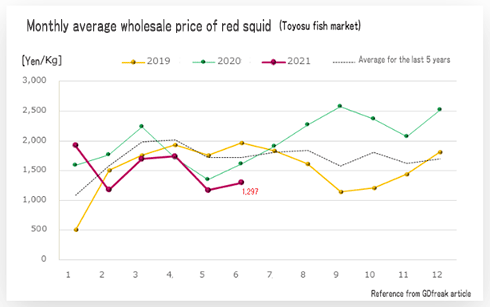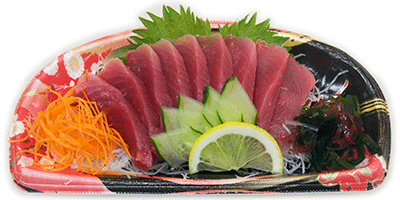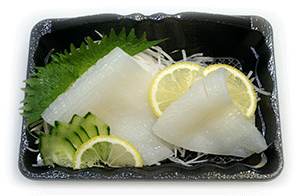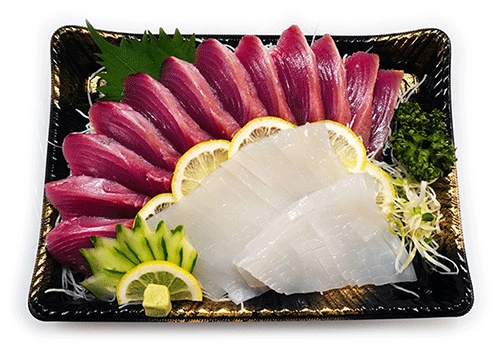| Please access the following URL if you want to secure using SSL. All pages in the site will be secure pages. |
https://secure02.blue.shared-server.net/www.fish-food.co.jp/message english 8.2021.html |
Welcome to FISH FOOD TIMES
Aug. 2021 issue No.212


Red & white assorted sashimi of bonito & swordtip squid
The market price of raw bonito is in the ¥150/kg
The market price of raw bonito is sluggish. The latest prices announced by Kesennuma Fish Market are as follows.

The Kesennuma fish market has been the largest bonito landing volume in Japan for 24 consecutive years until last year, and the price traded in this market is one of the national indicators. And let's take a look at what has happened to the transaction price of bonito in the Toyosu market, which is indispensable as another indicator of national fish prices.

After all, the Toyosu market also records the lowest wholesale price of bonito, which has not been seen in the past five years.
The swordtip squid has also fallen due to good catch that has not been seen in recent years.
Not only bonito, but also swordtip squid has become a good catch that has not been seen in the last 10 years, and the market price is declining. The swordtip squid's abundant fishing pace continued in various parts of western Japan, and good catch continued at the Fukuoka fish market from May to June.
The standard Japanese name Kensakiika is the local name Yariika in the Kyushu region, including Fukuoka. In Fukuoka, the name is Yariika, but in Yamaguchi, local names such as Shiroika, Maika, and Kenika are used, and there is also "Kottoiika" as a special brand squid in Yamaguchi.
Even in the same Yamaguchi region, the standard Japanese name Kensakiika has so many other names, so there are countless names on a nationwide scale. Therefore, from the standpoint of a person like me, I may have no choice but to ask the opposite question, "So ... what is the name of this squid in this area? ...".
Just in case, I would like to show the difference between swordtip squid and spear squid with an image.

The spear squid on the left side of the above image is in season from autumn to winter, and its morphological characteristics are that the tentacles are relatively short, and when it is landed on the ground, its body color turns brownish. On the other hand, many swordtip squids on the right of the above image are caught from spring to summer, and when they are landed, their body color becomes reddish, so they are also called red squid. The tentacles of the swordtip squid are longer than the spear squid.
It is clear from the graph below that the market price of swordtip squid is also declining in the Toyosu market, but in the Toyosu market, swordtip squid is represented by the common name in the Kanto region, neon red squid.

By the way, in Hiroshima, swordtip squid is called Mizuika, not Yariika or Akaika. In my mind, Mizuika was engraved as another name for Aoriika, so I was really surprised when I was told the name in Hiroshima about 30 years ago. Basically, it seems that different people living in remote areas can only use the standard Japanese name to have a common understanding of the name of squid, for example. However, as I traveled all over Japan to continue my current work, I decided to express myself according to the local local name instead of the standard Japanese name. That's because doing so facilitates local conversations. However, the problem is that I can't remember the names of the fish that are called in various places, and I often get stuck in words without remembering them. In particular, remembering local names in Okinawa and the Nansei Islands is a real hurdle. No matter how many times I hear the name of the fish, not once, there are many fish that I can't remember.
Background of sluggish fish prices and direction of fisheries section
I think it was around the time of the issuance of the new coronavirus emergency declaration last year that the slump in fish prices became noticeable. At that time, I remember that the market price of high-class fish, which was targeted at high-end restaurants, sushi restaurants, and Japanese restaurants, was particularly noticeable. The impact of the new coronavirus pandemic has entered the second year, and it seems that the impact of the slump in fish prices has begun to affect popular fish such as bonito and squid.
With the new coronavirus, the Delta strain is gaining momentum, and it is unpredictable how far it will spread. From the perspective of supply and demand for fish as a food ingredient, it is unthinkable for the time being that the price of fish will rise in the future in an environment where eating out with alcohol and dinner is difficult.
Before the Corona disaster, it was supposed that TOKYO 2020 would culminate in inbound demand, which would be a catalyst for economic revitalization. However, it is unlikely that TOKYO 2020 will be the driving force of the economy if domestic spectators cannot be attracted, let alone inbound, due to the fact that most of the games are unattended. For this reason, it is unlikely that demand for fish in the food service and tourism industries will increase for the time being.
For the fish retail industry, this August is the Bon Festival, which is expected to generate as much sales as the New Year's sales. Considering this year's case compared to last year's Bon Festival, which lacked excitement, the general view is that it is probably difficult to expect a significant improvement from last year, given the current situation. In the Bon Festival last year, local food supermarket stores that were originally booming due to the "hospitality demand of returnees" during this period, as local residents in the city tended to voluntarily refrain from returning to their hometowns. Then, the purchase volume of customers during the Bon Festival, which is supposed to be exciting with returning customers, has shrunk, and the unit price of customers per person has dropped significantly. As a result, sales were often negative, but on the other hand, many food supermarkets located in urban areas seemed to have increased sales.
Judging from the current situation, I don't think this year's Bon Festival will be much different from last year's. In other words, compared to the year before last when there was no corona sickness in local supermarkets, it is expected that the average customer price will decrease due to the same volume reduction as last year. On the other hand, urban supermarkets will receive the benefits of refraining from returning home from rural areas this year as well, and it is thought that they will be able to expect reasonable sales.
However, even in such a situation last year, there are stores in local supermarkets that did not reduce sales so much, and there are stores in urban supermarkets that did not increase sales much. Looking at what causes these differences, the author thinks that the "customer unit price" was the difference between victory and defeat in the major sales of events and festivals, including the Bon Festival and the year-end and New Year sales battle.
To put it simply, in a big sales battle such as an event or festival, "a store that can sell a lot of high-priced products has a high sales". And in that case, the method of "increasing sales by selling a lot of low-priced products" that is usually used is not effective. To put it more simply, "Bon sales battle and The year-end and New Year sales battle have high sales because the unit price of one item and the unit price of customers are high." Therefore, even under these circumstances in Japan, "in order not to reduce sales, we must make efforts not to reduce the unit price of each item and the unit price of customers."
However, as mentioned above, the market price of popular fish such as bonito and swordtip squid is now sluggish as well as high-class fish. Common sense says that this is an "opportunity for bargain sales," and it is natural for the unit price of each item to fall. In such a case, it is the second-class and third-class that can only sell cheaply as "Go to it, is ... more and more", and I think that such a merchant is not the first-class. Even if you can get fish cheaply, it is not easy to sell it cheaply, but by utilizing its experience and technology, it is a first-class business person to add value and finish it as a product with high cost performance that will make customers feel satisfied.
The commercial value of fish is not only good in freshness, but also in appearance, volume, and balance between price and quantity. And the author thinks that it depends on how close they are to the satisfaction level that the customer wants. In other words, just because you can get bonito and swordtip squid cheaply, it is important not only to sell them cheaply, but also to make positive efforts to make them valuable products and sell them.
It has been a long time since the fisheries section of supermarkets has been said to be unattractive from a management perspective. The author believes that the cause is that supermarket owners have positioned the fisheries section as a "retail sector" alongside processed foods. Actually, the fisheries section is not just a retail department, but it seems that there was a fundamental problem that it could not be regarded as a "manufacturing and retail department" that requires time and labor to manufacture. If it takes time and labor to manufacture fish products, of course, there will be no profit unless the selling price is set with the cost added. For this reason, unlike the retail department, which only purchases processed foods in case units, subdivides them, and sells them as a single product, it is natural that the calculation cannot be made with a markup ratio that is a little added to such a simple retail product. However, in the competitive environment of Japanese supermarkets, there has been no choice but to compete for bargain sales at a low markup ratio, and since this has been repeated for a long time, a fisheries section with low profits has become commonplace.
However, now that fish prices have been sluggish due to the great impact of the corona wreckage, there is a great opportunity to break away from the "bargain competition at low markup ratios" that the supermarket fisheries section has been repeating for a long time.
Realization of cost performance
Many fish products are now cheaper to buy than they were many years ago, so you don't have to forcibly sell them cheaply, so why not try to make them more attractive than just cheap? For example, let's consider one way to make raw bonito and swordtip squid, whose fish prices have been sluggish in this month's issue, attractive products.
In FISH FOOD TIMES, raw bonito was described in detail in last year's May 2nd issue of Reiwa No.197. In addition, Kensaki squid was described in the July 2013 issue No. 115, using the name of the local name Yariika, and "figure sashimi" was put on its first page image. If possible, please refer to this as well, but if you commercialize raw bonito and swordtip squid into simple single sashimi, an example like the image below can be considered.


This is an example of a product, but you should not sell it at a low unit price such as 398 yen because the purchase price of bonito is cheap and the swordtip squid is also cheap. If you do that, you will repeat the sales method of "increasing sales by selling a lot of low-priced products" above, and in the end it will be difficult to contribute to the fisheries section with profit unless you sell a lot of products.
So as a way to not lower the unit price, why not try to make such products.

Assuming that the selling price of the bonito and swordtip squid sashimi in the above image is set at 398 yen, it will be about 800 yen if the customer purchases both. However, considering the current sluggish market price of bonito and swordtip squid, it is considered unnecessary to put a selling price of 800 yen for assorted sashimi that combines this bonito and swordtip squid, and a selling price of 680 yen is not impossible. Perhaps, sometimes it is possible to calculate the selling price of 580 yen, but if you move toward a lower unit price and lower unit price, the meaning of this commercialization will be diminished.
The aim of this product is good cost performance that makes customers feel that "this selling price with this volume ...? This is a bargain". If the cost of purchasing fish is high, it is difficult to achieve such a thing, but given the current slump in the market, without compressing the markup ratio in the fish section, we can propose "win-win products" that customers will be pleased with with a high level of cost performance.
For example, if you want to make sushi, you can make such a product.

In this assorted sushi plate, the belly body of bonito is made into yushimo with the skin and cut into sushi material, and the swordtip squid is made into matsukasatsukuri's decorative knife and made into searing to make sushi. The cost of this assorted sushi is not so high for each swordtip squid, but it is surprisingly cheap for bonito, calculated from the current market price. Therefore, this assorted sushi plate with 10 cans of nigiri sushi should have a sufficient markup ratio even if it is set at a selling price of 680 yen.
Opportunity to improve profits in fisheries section
Well, I've used the terms profit and markup ratio a lot in this month's issue, but I hope readers don't get me wrong. That is to say, I'm not just recommending that you make more money by taking advantage of the current low fish price situation.
On the contrary, I may be afraid. Not only bonito and swordtip squid, but also marine products are generally cheap, but they are just happy that the selling price remains the same and the rate of purchase is high. I wonder if the fishery staff has a negative attitude toward sales, which puts the highest priority on profits, by not trying to increase sales by using the low fish prices to move more fish.
In doing business with fish, we must be prepared for the fact that the market price of fresh fish is not constant and fluctuates. In the old days, fish stores used to use the "double-multiplier commercial law" method, which always ensures a high purchase rate linked to the purchase price. Anyway, it is a business method that "prioritizes profit margin" in order to survive and continue business, but with the advent of the fish section of the supermarket, the fish shop of the family business that takes such a business method loses the competition , and was weeded out from the town. On the other hand, the fish section of the supermarket operates a fishery department with a low markup ratio, which is different from the fish shop in the town, and although there were some that had high apparent sales, the actual gross profit was eaten by labor costs and other costs, and the fisheries most of the sections have been in the red and have continued to this day.
In this way, the supermarket fisheries section is by no means an honor student in terms of current profit by department. If possible, I would like the department to be proud of its contribution to profits, but it is structurally difficult to rationalize the fisheries section, such as mechanization. This is because it is not easy to secure current profits by sector because the labor-intensive aspect cannot be completely removed. The fisheries section has a long history of facing such challenges.
However, due to the impact of the corona wreck that has continued since last year, the delivery route for marine products to the food service industry has been blocked, the relationship between supply and demand has collapsed, and the market has been sluggish. It is the second year since last year that it has become the main underwriter of the company and is increasing sales by taking advantage of the tailwind of stay-at-home consumption. This tailwind should be seen as an opportunity to change the profit structure of the fisheries section, so why not review the sales method itself of the supermarket fisheries section as "increasing sales by selling a lot of low-priced products"? It must be said that simply raising the markup ratio and raising the selling price is not enough to review the unit price of a product. Instead, as a hint, I introduced an example of sashimi and sushi with assorted bonito and swordtip squid in the first page image in this month's issue.
The ideal is "The selling price of the product itself is not always cheap, but the price is voluminous, it looks good, and the balance is good, so it feels like a bargain, and the satisfaction is high, if opportunity. If there is, I would like to buy the same product again. " It is a product that customers can repeat.
In August, due to watching TV at the Olympic Games, refraining from traveling to Obon, eating out and refraining from dinner, Japan should have a higher demand for drinking at home due to its quiet stay home than last year. This month, one way might be interesting, and I hope the August numbers will give good results.
| Please access the following URL if you want to secure using SSL. All pages in the site will be secure pages. |
https://secure02.blue.shared-server.net/www.fish-food.co.jp/message english 8.2021.html |
An opinion and the communication are to iinfo@fish food times
Date of updating 1 Aug. 2021
